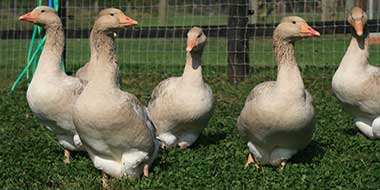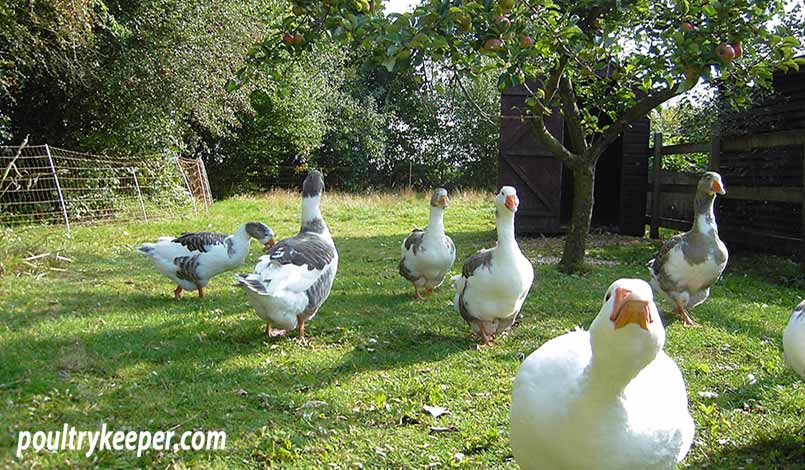
Traditionally, in Europe, people kept poultry in orchards. Chickens and waterfowl would eat insects and fallen fruit, and geese would keep the grass short. Droppings helped provide nutrients for the trees, and the trees provided shade, shelter and safety from overhead predators. In this article, I show you how I went about creating an orchard for poultry.
Our family eats a lot of fruit, and I love the idea of pressing my own apple juice to drink or to turn it into apple cider vinegar. Our chickens also needed some cover, so I started to think about creating a poultry orchard.
The origins of chickens are, of course, the Jungle Fowl of Asia, where they naturally live under the dappled shade of the trees. Trees make chickens feel secure, providing them with protection from birds of prey, and you’ll notice they prefer to sit in the shade on hot days to keep cool, so it seemed like a perfect solution to create a poultry orchard in my largest poultry run.
The importance of shade
Poultry can handle the cold rather well. In Canada, there are temperatures of -20˚C and below and poultry are still being kept. Chickens can fluff out their feathers, just like wild birds and trap air to insulate them against the cold, but what about the heat (of our British Summers…)?
Chickens can’t sweat, so they can only cool down by panting to remove heat in the air they expire or by taking on more water and excreting more fluids to remove heat from their body.
Providing shade for chickens or any other type of poultry is essential on hot days and keeping their water cool or at least shaded helps them cool them down as the temperature rises.
Creating an orchard for poultry
I aimed to create a ‘Traditional Orchard’ that my poultry use as a run. It is fenced to provide them with security from predators such as foxes and badgers whilst I work during the day.
The birds will do their bit with insect control, and we intend to manage the orchard without chemicals that could cause harm to the local environment or our chickens, ducks and geese.
Young fruit trees need protection from geese because, occasionally, they will pull at the bark, causing damage.
My first step to creating an orchard for poultry was to purchase fruit trees from Ashridge Nurseries, a Somerset based mail order nursery.
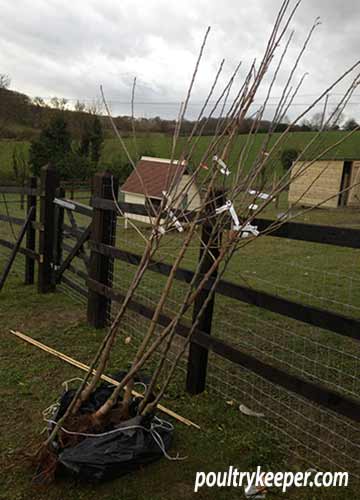
When to plant the trees
Fruit trees should be planted during the winter months when the sap has stopped rising. It’s quite a shock to a tree to be uprooted and replanted so it’s important to have the ground well-prepared before trees arrive. Apparently, the goodness is stored in the roots through the winter so avoiding disturbance and root damage is very important.
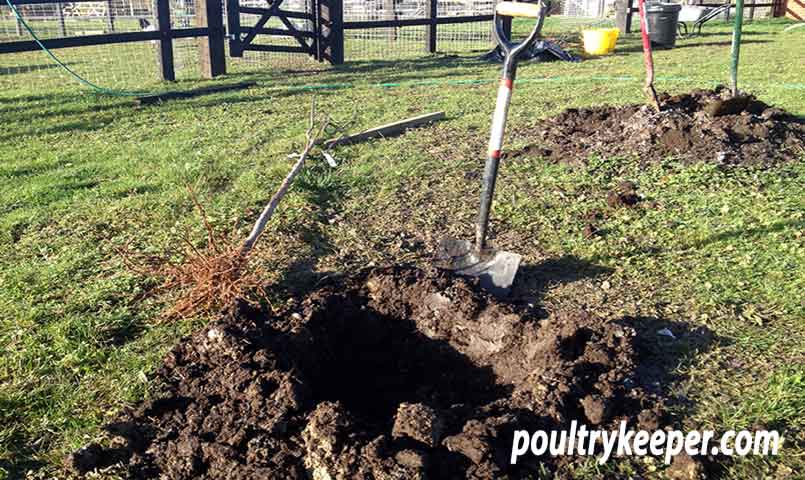
Preparing the ground
I prepared the ground by digging out a large circle to a spade’s depth. The soil in the central part of this area was then loosened further (since we have clay soils here) and this was mixed with well-rotted horse manure.
The whole area was then filled with a mixture of rotted horse manure, and sandy topsoil.
A stake was driven into the centre of the prepared area and some chicken netting was placed over the area and pegged down to stop the chickens from scratching it all out again!
This will also stop the geese from nibbling the young trees as well.
Rootgrow
I used Rootgrow sold by Ashridge Nurseries on the bare roots before planting to give the trees a good start.
Rootgrow is made from naturally occurring fungi and is applied as a gel directly to the roots before planting them. The main ingredient is mycorrhizal fungi. These are organisms that co-exist naturally with the roots of trees. I prepared the solution in an old plastic waste bin and then dipped the roots in before planting the trees.

After part planting the roots, I gave the area a light topping of Bonemeal (slow-release fertiliser) and then covered this with more soil.
The level of soil should match the ‘tide mark’ where the tree was previously planted. The graft (all fruit trees are grafted onto rootstock these days) should be well above the soil level.
When choosing fruit trees, you often need a pollination partner from the same group, or a group above or below. This basically means your trees will be in flower at the same time, or will overlap at some point allowing insects to pollinate them.
Fencing
The fencing we decided to erect was a little overkill for poultry but we wanted the orchard area to be secure from other livestock as well as look good. We decided to use some re-cycled Tundra wire that we had from an old fence. We opted for post and rail fencing on the outside, to match other fencing and electric wires were added on insulators to stop foxes from digging or climbing.
Protecting the trees from geese
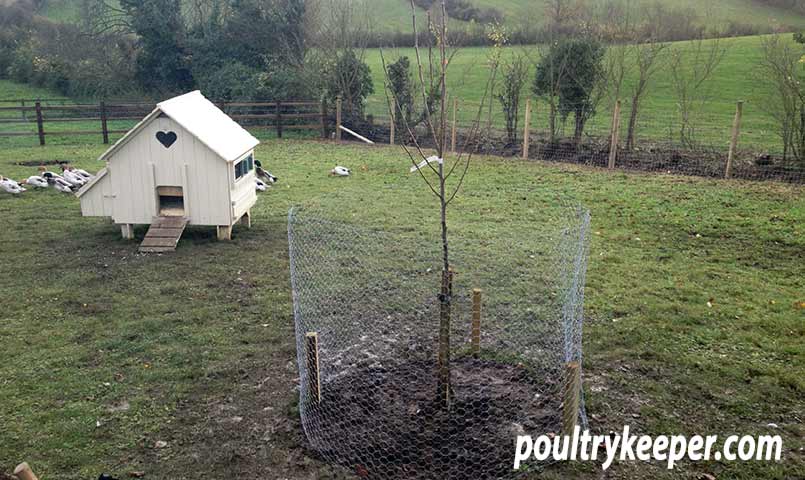
If you keep geese like me, then geese will damage young trees. We used the spiral tree protectors around the base of the trees, but they could still reach the lower branches. As mentioned above, chickens will scratch loose soil at the roots of newly planted trees, so to protect the trees in our poultry orchard, I made some loops of chicken wire to go around the trees to protect them until established.
Although the weather was cold and wet, and I created a lot of mud, the results were very pleasing.
Once I had finished creating an orchard for poultry, I just had to remember to water the trees and be patient, waiting for them to start to grow.
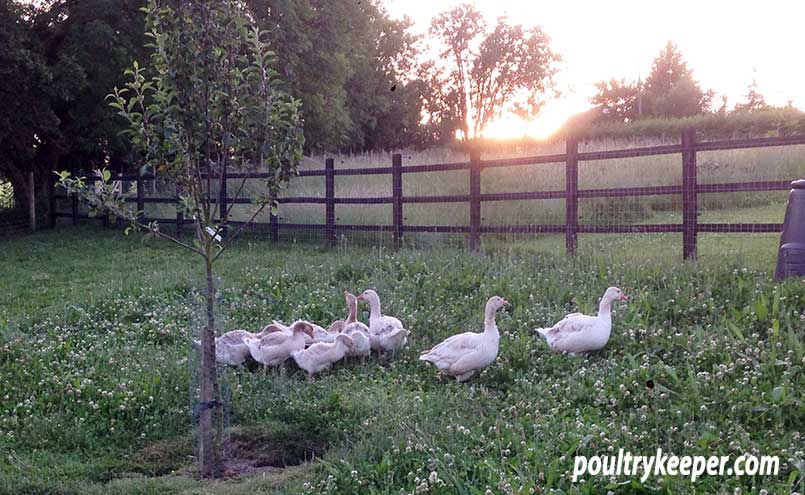
Our Brecon Buff geese graze the grass in the orchard with their goslings.




